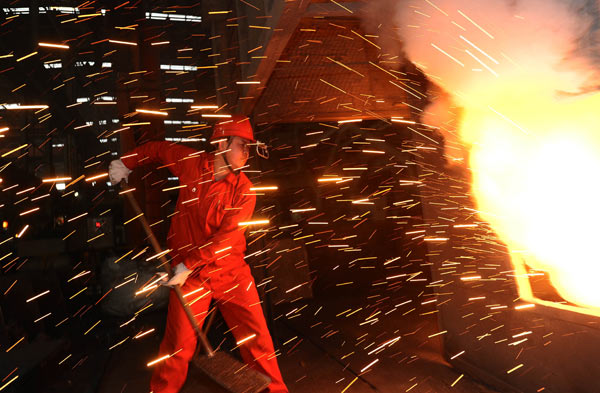Steel industry may hit CO2 objectives early


China is the world's largest steel producer and consumer, and the steel industry will face "absolute control" over its total carbon emissions from "relative control" over its carbon emission intensity per unit of steel production, and accelerating adoption of low-carbon growth pathways is also important for the whole industry to upgrade and achieve high-quality development, it said.
Steel companies must further optimize processing procedures and raw material mixes, increase utilization of recycled resources such as scrap steel and pellets, and adopt short-process electric furnace steelmaking to reduce carbon emission intensity per unit of steel production, according to the initiative.
The industry should actively use clean energy such as solar, wind energy, hydrogen and biomass energies, collaborate in the research, development and application of technologies for non-fossil energy, biomass energy and energy storage, and explore the construction of smart power supply networks that combine the use of clean energy and byproducts such as gas and waste heat, the initiative suggested.
The initiative also asked the industry to increase investment in scientific research and development to make breakthroughs in low-carbon metallurgical technologies such as hydrogen-based technologies, and to strengthen application of low-carbon technologies such as carbon capture, utilization and storage technologies.
Steel mills should carry out more innovative research to develop high-quality, high-strength, durable and recyclable steel products, cooperate with authorities on carbon trading policy implementation and carbon market construction, and promote low-carbon lifestyles among employees, it said.
Experts said the steel industry should reduce emissions through upgrading facilities, such as encouraging the use of electric arc furnaces, increasing the usage of scrap steel in steelmaking and adopting hydrogen-based steel production technology.
The CISA said authorities are conducting research to devise an action plan for the steel industry to further reduce its carbon footprint.
The industry is expected to accelerate the application of non-fossil fuel energy, especially the use of hydrogen as fuel, while continuously optimizing raw material structures and energy mixes.
It will also encourage steelmakers to adopt green development throughout the product life cycle, while vigorously promoting green steel product design at steel mills, as well as use high-strength, long-life and recyclable products in the downstream sector.
In addition, steel frame building technologies will also be promoted to raise awareness about green steel consumption.
During the 13th Five-Year Plan period (2016-2020), China met its target ahead of schedule of cutting excess steel capacity by 150 million metric tons. Energy consumption per unit of industrial output by China's designated large enterprises also saw a significant drop, according to the ministry.
Xiao Yaqing, minister of industry and information technology, said at a work conference in December that China will resolutely cut crude steel output and ensure it falls year-on-year in 2021, and efforts will be made to promote low-carbon industrial development and green manufacturing this year.
The CISA said the steel industry had achieved another round of improvement regarding the efficient use of energy and resources last year.
Average energy consumed per ton of steel produced by key steel enterprises was equivalent to 545.27 kilograms of standard coal last year, down 1.18 percent on a yearly basis.
Water intake for every ton of steel produced fell 4.34 percent on a yearly basis, while sulfur dioxide emissions decreased 14.38 percent. The utilization rate of steel slags and coke gas increased on a yearly basis, albeit slightly.
In 2020, China's crude steel output increased 5.2 percent year-on-year to exceed 1.05 billion tons.
The output of pig iron rose 4.3 percent from a year earlier to 887.52 million tons.




































